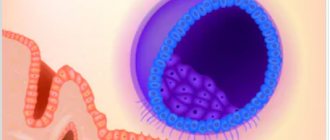After pregnancy and childbirth, a woman’s body does not come to its senses immediately - it takes time for the organs and systems to fall into place and begin to work in their usual rhythm. During the process of this recovery, the woman continues to have discharge after childbirth - lochia.
Young mothers have many questions about lochia, and the most popular of them is how long does the discharge last after childbirth? In addition, women want to know the symptoms and signs they should pay special attention to so that they can take the necessary measures in advance. We'll tell you everything in detail.
Discharge after childbirth: what should it be like?
Bloody discharge that begins immediately after childbirth (lochia) is profuse. Perhaps many women will be surprised that in the first postpartum days they will be offered to use not sanitary pads, but ordinary absorbent diapers. If you are unaccustomed to this, this will not be very convenient, but for a doctor to evaluate the discharge, the use of diapers is most convenient: this allows you to study the composition, color and smell of lochia.
For several postpartum days, the discharge should be red and have a slightly sweet smell of blood. The discharge for the most part consists of unchanged blood, as well as the secretion of the uterine glands, which becomes active precisely after childbirth.
Gradually, over the next days and weeks, the amount of discharge will become less and less.
If the volume of discharge after childbirth does not decrease gradually, but suddenly and sharply, and at the same time it is colored brown, such facts are considered a deviation from the norm and a signal of the presence of cervical spasm. The opposite picture, when there is an extremely large amount of discharge, is also a pathology, because with such signs the contractile activity of the uterus is most often disrupted and there are problems with blood clotting. Under such circumstances, DIC syndrome (thrombohemorrhagic syndrome) may develop, which is considered a life-threatening condition and requires certain treatment.
Deviations from the norm
Signs of deviations from the norm after childbirth can be different - the presence of violations may be indicated by a change in the duration or nature of the discharge. If lochia goes on for too long, suddenly ends and starts again, the woman should consult a doctor. Greenish or purulent discharge with an unpleasant odor is also an alarming sign - they indicate the presence of infection in the genital tract.
Fever, severe pain, a feeling of bloating or heat in the vagina require immediate help - if such symptoms occur, you should call an ambulance. Postpartum pathologies (hydatidiform mole, puerperal fever, infectious and inflammatory processes) can lead to unpleasant consequences, so they need to be identified and eliminated as soon as possible.
Any delay can lead to serious deviations, as a result of which the woman may lose her reproductive organs.
| Time after childbirth | Nature of the discharge |
| First 2-3 days | Bloody discharge with a liquid consistency of bright scarlet color, which resembles fresh blood, with a total volume of about 500 ml. |
| 7-10 days | A fairly thick, dark secretion with admixtures of mucus, pieces of epithelium and clots, the total volume is no more than 300 ml. |
| 2-3 week | Discharge that resembles ichor is liquid, brownish in color, odorless and impurity-free. |
| 3-4 week | A yellowish secretion is released in small quantities and becomes lighter every day. |
After 40-62 days, the lochia ends completely, and the discharge becomes normal - the same as it was before pregnancy. This indicates the healing and complete restoration of the uterus, as well as its readiness to bear a child. For two months after giving birth, a woman should carefully monitor her own condition - any pathologies that arise during this period can cause serious complications.
Causes of discharge after childbirth
Discharge after childbirth is a normal and long-lasting phenomenon, and its presence is mandatory in a healthy woman, regardless of how her birth took place. Lochia is released because once the placenta has separated from the surface of the uterus, the organ is an open wound that needs time to heal. During pregnancy, the endometrial layer in the uterus has significantly increased, and at the end of the birth process it is rejected by the uterus, after which it begins to decrease in size. In the maternity hospital, the process of lochia discharge is controlled by a gynecologist, and after discharge, the woman needs to independently monitor the discharge, or rather, its color, volume and smell.
Postpartum endometritis
This is a dangerous complication that can occur after childbirth. The term means an inflammatory process in the uterus. A pregnant woman's body's defenses are weakened so that the body does not mistake the fertilized egg for a hostile foreign object. Then the immunity returns to its previous state 5-6 days after birth. If there was a caesarean section, then the restoration of immunity should only be expected on the tenth day. Decreased immunity threatens inflammatory diseases of the reproductive system. There are also risk factors for developing postpartum endometritis :
- abortions
- history of fibroids or inflammation of the uterus
- age under 18 and over thirty years
- poor nutrition
- alcoholism, drug addiction, smoking
- endocrine diseases
- Caesarean section performed before the baby is conceived
- unfavorable living conditions
- chronic extragenital pathologies
Factors for the development of the diagnosis in question during childbirth:
- more than 3 vaginal examinations to diagnose the obstetric picture
- a period without water of more than 12 hours
- protracted labor
- manual control of the uterine cavity
- obstetric aids during childbirth
- performing a caesarean section
- anomalies of ancestral forces
- premature (too early) birth
- clinically narrow pelvis
Factors in the development of postpartum endometritis during pregnancy (before childbirth):
- threat of miscarriage
- infection of the vagina before childbirth with various STDs
- abnormal development of the placenta
- infections in pregnant women
- exacerbation of chronic inflammatory diseases during pregnancy
- vaginal inflammation
- inflammatory process in the cervix
- treatment of isthmic-cervical insufficiency with surgical methods
- bearing several fruits at once
- polyhydramnios
- large size/weight of the unborn baby
- incorrect position of the child
- anemia
- toxicosis that began after the 20th week
What affects the duration of discharge after pregnancy?
After returning home, one of the desires of a young mother (after the dream of sleeping and eating) is the need to get rid of discharge and change pads as quickly as possible, because all this becomes an obstacle to intimate communication. Therefore, a woman always asks the question: how long does the discharge last after childbirth? In fact, the recovery time of the uterus for each woman in labor varies, because its duration is influenced not only by the course of the birth itself, but also by the individual characteristics of the female body. Typically, lochia lasts about a month, although some women continue to shed it for another week or two. It affects the duration of lochia discharge and the process of breastfeeding, because frequent feedings provoke stronger uterine contractions.
If, after a month and a half, a woman observes bleeding after childbirth, she needs to contact a gynecologist to undergo an examination. A sharply increased volume of discharge will most likely alert the doctor. He will determine the reasons for the prolonged recovery period and decide what to do, since too much blood loss is fraught with certain problems for the young mother.
The maximum duration of lochia discharge should not exceed two months. And if this period drags on, it will be necessary to take action. If the period of discharge was too short, this is also a reason to see a doctor. Perhaps the mother's body really recovered faster than usual. But much more often, short-term lochia is associated with a pathological process - the accumulation of blood in the uterus and the inability to remove it out. In this case, the young mother must be hospitalized to help her body cleanse itself of residual effects and not provoke an inflammatory process.
What do normal lochia consist of?
Normal discharge looks like blood clots formed by the placenta and endometrium and will take about a week to clear naturally from the uterus. After a week, the composition of the lochia will change: they will become more liquid-like, sometimes mixed with blood mucus, which is a product of the child’s intrauterine vital activity. It will also take about a week to remove them. After a month, the lochia will be more smearing than flowing, more and more reminiscent of normal menstrual flow. Such described phenomena are considered normal and should not cause concern in a woman.
Why pathologies occur and how to notice them in time
Purulent discharge is pathological , no matter in what postpartum period it begins. The cause of purulent discharge is most often infection, resulting in an inflammatory process. Often, discharge mixed with pus is accompanied by an increase in body temperature and a pulling pain in the lower abdomen. The appearance of such lochia resembles a viscous mixture.
Watery translucent discharge , should also be considered a pathology . They may be a sign of gardnerellosis (bacterial vaginosis) or the separation of fluid from the lymphatic and blood vessels.
What should the color and smell of the discharge be?
- Normally, during the first three postpartum days, the discharge should be bright red, since the blood has not yet had time to clot. When the clotting process has already begun (this will take about two weeks), the lochia becomes brown. Towards the end of the discharge (a month after birth), the lochia takes on either a transparent or pale yellowish color.
- Pathology is signaled by bright yellow discharge with a greenish tint and a sharp unpleasant odor: if it appears five days after birth, the uterine mucosa may be inflamed; if after two weeks, endometritis has probably begun in the woman’s body (an inflammatory process in the endometrium - the internal mucous layer of the uterus). Green discharge can also be a sign of endometritis, but with this color of discharge, the pathological process is already quite serious. Therefore, even if a yellow admixture of pus appears in the discharge, it is necessary to urgently contact a gynecologist. The curdled consistency of the discharge accompanied by a sharp sour odor accompanied by redness, inflammation and itching indicates the presence of thrush or infection. Black discharge may indicate hormonal imbalance. Although they most often cause a woman to panic, there is no need to worry, especially if there are no other symptoms. Just tell your gynecologist about them, and he will decide whether something is worth doing.
- to the smell of discharge , since many things can be judged by its specificity. Normal discharge after childbirth initially has a characteristic smell of blood (resembling the smell of dampness, moisture), and after a couple of weeks it becomes a little musty. Any strong odors—sour, putrid, “fishy”—should always alert you. If unpleasant odors are also accompanied by an abnormal color and an increase in the volume of discharge, then, most likely, infection or inflammation has begun.
Additional signs of inflammation are:
- pain in the lower abdomen;
- dizziness and weakness;
- increased body temperature;
- pathological symptoms of volume, smell and color of discharge.
Popular questions
Hello.
In the postpartum discharge I saw a clot that probably even looked like a piece of flesh, a very dense burgundy clot. What it is? Hello! Lochia after childbirth normally persists for up to 43 days, its nature can vary from bloody-mucous to bloody. When the uterus contracts, blood clots may be present in the discharge. To exclude remnants of placental tissue, an ultrasound of the pelvic organs can be performed.
Nine days have passed since the birth, the discharge has stopped altogether, it hasn’t been there for a day, but now it’s pouring. This is fine?
After childbirth, discharge (lochia) can last up to 42 days. The nature and abundance may vary.
Good afternoon The question is: after childbirth, natural lubrication disappeared, is it possible to somehow restore it without additional gels? Hello! Replenishment of the lack of hydration of the mucous membranes after childbirth occurs gradually. Depends on the duration of lactation, the resumption of the menstrual cycle, injuries to the mucous membranes, the emotional factor, the woman’s daily routine and much more. At this stage, it is better to use lubricants, which will prevent additional injury due to dryness. For this purpose, you can use Ginocomfort gel with mallow extract. This will not affect the quality of lactation.
Can menstruation begin exactly one month after giving birth while breastfeeding? It started on the 21st, today the 27th it started pouring heavily in the morning. I’m afraid to go to the hospital, and there’s no one to leave the child with.
Hello!
Bloody discharge from the genital tract normally continues up to 43 days, the intensity of the discharge may vary. To rule out other causes of postpartum hemorrhage, such as placental remnants or lochiometers, you need to perform a pelvic ultrasound. For an accurate diagnosis, contact a specialist
Preventive hygiene after childbirth
To prevent bacteria from multiplying in the moist environment of lochia, it is necessary to carefully follow the rules of personal hygiene :
- when choosing sanitary pads for the period of discharge, prefer special, postpartum products; the best option would be absorbent diapers (at least for the period of stay in the maternity hospital);
- change pads regularly, every 4-5 hours, paying attention to the intensity of the discharge;
- do not use sanitary tampons;
- wash regularly, directing the water stream from front to back;
- When treating sutures placed on the perineum, after washing, use rinsing with antiseptics - a solution of furatsilin or potassium permanganate.
Hygiene for lochia
In the postpartum period, a woman should pay attention to personal hygiene. You will have to give up aggressive detergents, as they can seriously disrupt the vaginal microflora. It is better to choose special soap for intimate hygiene.
It should not contain:
- parabens;
- silicones;
- Sodium laureth sulfate.
It is better to give preference to soap made from natural ingredients. Hygiene procedures should be carried out twice a day.
ONLINE REGISTRATION at the DIANA clinic
You can sign up by calling the toll-free phone number 8-800-707-15-60 or filling out the contact form. In this case, we will contact you ourselves.
If you find an error, please select a piece of text and press Ctrl+Enter
Discharge after cesarean section: normal and pathological
Immediately after a cesarean section, the discharge is similar to the “classic” heavy menstruation - just like after a physiological birth: the lochia is bright red in color and contains clots. During the week after a cesarean section, the lochia will be very abundant, filling the absorbent diaper or pad completely in about a couple of hours. When performing a round and examining postoperative sutures, the gynecologist will definitely ask you about the color and volume of the lochia.
When the new mother begins to get up and move more after surgery, the discharge will begin to increase. The same will happen during breastfeeding and when the doctor palpates the abdominal area during examination. All this stimulates uterine contractions, so the remaining lochia come out more actively.
Just as after physiological childbirth, lochia will begin to acquire a darker, brownish tint and decrease in volume after about one to one and a half weeks. The discharge will become spotty and light in color in the fifth postpartum week. And in the eighth week, the inner layer of the uterus will almost be restored, and the discharge will acquire a light shade, as it was during the usual menstruation before conception.
This period is ideal for consulting with a gynecologist about the choice of contraception, since after a cesarean section you must wait a certain period before the next pregnancy (as a rule, it is recommended to wait more than one year).
A woman who has undergone a cesarean section needs to know that the process of contraction of the uterine myometrium after surgery does not proceed as quickly and naturally as after physiological childbirth. After all, the myometrial muscle fibers are damaged after a surgical incision. Oxytocin, which is administered to the young mother immediately after a caesarean section, helps to help the uterus contract more actively and prevent postpartum hemorrhage. And in order for the female body itself to establish the production of oxytocin, it is necessary to switch to breastfeeding as early as possible.
Hygiene rules after surgery
- It is necessary to change sanitary pads regularly - preferably every 2 hours;
- all secretions must come out and be carefully controlled, therefore it is forbidden to use hygienic tampons, which can cause infection;
- It is necessary to wash and shower regularly; It is advisable not to use gels, soaps and other products with fragrances - it is better to use safe children's toilet soap; when washing, direct the stream of water and movement from front to back;
- until the body recovers, douching and taking a bath should not be done;
- try to fall asleep on your stomach in the first weeks after childbirth: this way the lochia will come out faster and the uterus will contract much more actively;
- to help the uterus contract normally, follow a drinking regime and diet that will help you empty your intestines and bladder in a timely manner; when the organs are full, they put pressure on the uterus, preventing it from making contractile movements;
- do not begin sexual activity until the recovery process is completely completed and the discharge has completely stopped.
Recovery in the postpartum period
Breastfeeding an infant
Every woman in the postpartum period should know that breastfeeding is an excellent prevention of all kinds of complications. After all, when a baby is applied to the breast, there is an immediate release of the hormone oxytocin, which also causes contractions of the uterus. After feeding, a woman may observe a visible increase in discharge, which is associated precisely with contraction of the muscles of the uterus and should not cause concern.
To speed up uterine contractions, you should empty your bladder in a timely manner. During the postpartum period, it is advisable to do this every three hours, even if the woman does not have a pronounced feeling of bladder fullness, and to avoid constipation.
For 1-2 months after giving birth, discharge cannot be absorbed with tampons, precisely because they do not remove lochia, but simply absorb them. This can lead to the proliferation of pathogenic bacteria and microorganisms. It is recommended to use pads or diapers instead of tampons. Choose unscented products, as you need to control not only the color and number of lochia, but also their smell.
It is extremely important to maintain good personal hygiene. You should especially carefully monitor the hygiene of the genital organs one to two weeks after childbirth, when the discharge is still bloody. During this time, it is forbidden to take a bath, limiting yourself to showering only. The stream of water from the shower should not be very strong and should be directed from front to back - and only from the outside. To safely clean the external genitalia and vaginal mucosa, it is recommended to use special products - for example, washing gels for intimate hygiene Ginocomfort. These products were developed by specialists from the pharmaceutical company VERTEX, are characterized by a safe composition, including natural active ingredients, and also have all the necessary certificates, certificates and other necessary documents.
Sexual rest continues up to 42 days, and intimate relationships are resumed only after a control ultrasound of the pelvic organs, examination by an obstetrician-gynecologist and an adequate selection of a contraceptive method.
Exercising after childbirth
Sources:
- EARLY DIAGNOSIS AND PREVENTION OF SUBINVOLUTION OF THE POSTPARTUM UTERUS. Naumkin N.N., Ivanyan A.N., Smirnova T.I. // Bulletin of new medical technologies. – 2008. – No. 2. – pp. 46-48.
- CYTOLOGY OF UTERINE LOCIA IN ENDOMETRITIS AFTER BIRTH. Kupert M.A., Kupert A.F., Solodun P.V. // Acta Biomedica Scientifica. – 2004. – No. 2. – pp. 172-175.
- Cystic fibrosis: modern achievements and current problems. Kapranov N.I. and others // M., 2005.
- The importance of cytological examination of lochia in assessing the condition of the uterus in the postpartum period. Z.K. Fursova. A.P. Nikonov, N.A. Lutfulaeva, E.A. Kuchuchurova // Obstetrics and gynecology. - 1991. - No. 1. pp. 45-49.
- Postoperative purulent-septic complications in obstetrics (prediction, prevention, early diagnosis and therapy). Kryukovsky S.B. // Dis. Dr. honey. Sciences. – M., -2002. – P. 266.
- https://www.aafp.org/afp/2017/0401/p442.html
- https://www.pubfacts.com/detail/19674353/Early-postpartum-discharge-and-breastfeeding-an-observation…
- https://parenting.firstcry.com/articles/lochia-normal-bleeding-and-discharge-after-pregnancy/
What else is important to know about discharge after childbirth?
Not only pathologies during discharge, but also the accompanying symptoms of inflammation should be alarming and cause certain concerns - as a rule, they are increased body temperature and abdominal pain. If there are no pathological impurities in the discharge and the stomach does not hurt, and the only strange symptom is fever, do not worry - most likely, this is due to the establishment of lactation. When the lactation process has not yet stabilized, the young mother will feel the first rush of milk, which is accompanied by a slight increase in temperature.
If a woman does not properly care for the sutures placed as a result of a cesarean section, they may become infected. In this case, discharge will begin to appear from the stitches. This symptom is usually accompanied by a sharp increase in temperature, swelling in the suture area, and the discharge itself may be mixed with pus and blood. Under no circumstances should you start this process and try to cope with the infection on your own - you must urgently consult a doctor for help so that self-medication does not lead to dire consequences. Otherwise, the new mother may need another surgery.
As a rule, upon discharge from the maternity hospital, the stitches gradually begin to return to normal, and the woman is informed in detail by the doctor about how to care for them at home. If everything is in order during the postpartum recovery period, you will need to visit a gynecologist after a cesarean section two months later. During this time, it is necessary to conduct careful self-monitoring, and in a critical situation, urgently consult a doctor.
Lochiometra
This condition is also a complication after childbirth. During the development of lochiometra , lochia lingers in the uterus. In most cases, this condition appears 7-9 days after the baby is born. This complication can be caused by the following reasons:
- blockage of the cervical canal of a mechanical nature;
- insufficiently active uterine contraction;
- the presence of a mechanical obstruction in the cervical canal (blood clots, remnants of membranes, decidua);
- the uterus is bent forward too much.
If during pregnancy there is overdistension of the fetal sac, and this happens with multiple pregnancy, large fetal size, polyhydramnios, the ability of the uterus to contract weakens. This also happens with prolonged or rapid labor, incoordination of labor, cervical spasms, and caesarean section.
If lochiometra is diagnosed on time, then the woman’s general health does not have time to deteriorate, her pulse and body temperature do not change. In this case, the only sign of a pathological condition is very scanty discharge during a period when it should be abundant, or it stops completely.
In this case, lochiometra treatment is carried out after childbirth, and the woman’s condition gradually improves.
If the lochiometer is missed, if the doctor palpates the uterus, pain is noted, and he also notes that the size of the uterus has increased compared to the previous day. If the lochiometer was missed, the woman may subsequently develop endometritis .
Therefore, it is important to know what the normal discharge rate should be after childbirth, and to consult a doctor in a timely manner if certain violations occur. Therapy consists, first of all, of ensuring the outflow of lochia from the uterus. Initially, the doctor prescribes conservative treatment:
- parenteral use of papaverine or no-shpa ;
- uterotonics ( oxytocin ), applying cold to the lower abdomen.
If a woman is diagnosed with a kink in the uterus, the specialist performs bimanual palpation to return it to its normal position.
If the cervical canal is blocked, the specialist carefully widens it with a finger. Sometimes special devices are used for this purpose - Hegar dilators.
Provided that all the measures described above did not lead to the elimination of the pathological condition in 2-3 days, curettage is performed - emptying the uterine cavity using instruments. Vacuum aspiration can also be used. To prevent inflammatory processes, women are prescribed antibiotics.
How long the lochia lasts after curettage depends on the period when the procedure was performed.










